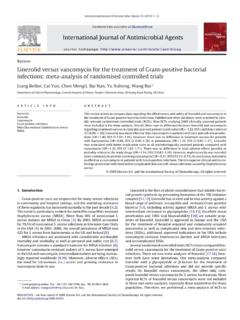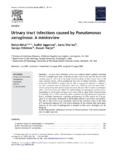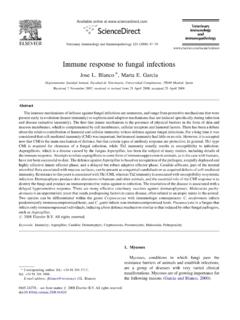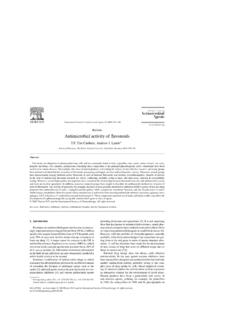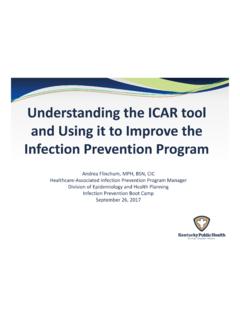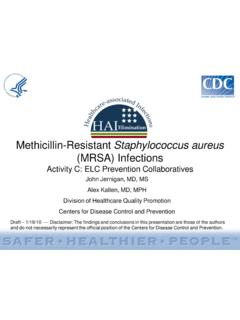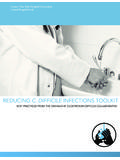Transcription of Mini-review Antiviral drugs for cytomegalovirus …
1 Antiviral Research 71 (2006) 154 163. Mini-review Antiviral drugs for cytomegalovirus diseases Karen K. Biron . Department of Clinical Virology, Division of Virology, GlaxoSmithKline Inc., RTP, NC, United States Received 15 March 2006; accepted 4 May 2006. Dedicated to Prof. Erik De Clercq on the occasion of reaching the status of Emeritus-Professor at the Katholieke Universiteit Leuven in September 2006. Abstract cytomegalovirus infections are associated with severe morbidity and mortality is patients at risk for disease because of immune system disabilities;. in particular, recipients of stem cell (HSCT) or solid organ (SOT) transplants. There are three systemic drugs approved for CMV treatment: ganciclovir, or its prodrug valganciclovir, foscarnet, and cidofovir. An anti-sense therapeutic, ISIS 2922, is also approved specifically as in intravitreal treatment for CMV retinitis. Ganciclovir, and more recently, valganciclovir, have been useful in proactive approaches of CMV disease management; in both prophylactic and preemptive regimens in HSCT and SOT populations.
2 The major anti-herpes agent valacyclovir has also been approved for prophylaxis of renal transplant recipients, or SOTs outside of the US. These drugs have provided major advances in CMV disease management, although they are limited by intolerable toxicities, oral bioavailability and efficacy, and risk of drug resistance with extended use. Several drugs are in early clinical development which may address these limitations; this review will provide an overview of our current arsenal of available drugs , and of those in the early clinical development pipeline. 2006 Elsevier All rights reserved. Keywords: CMV; Nucleoside analog; Nucleotide analog; Pyrophosphate analog; Novel benzimidazole riboside Antiviral drugs ; Alkoxyalkyl esters of cidofovir;. Ganciclovir; Valganciclovir; Valaciclovir; Foscarnet Contents 1. CMV infection and CMV disease .. 155. 2. Congenital CMV infection .. 155. 3. CMV-associated disease in transplant recipients .. 155.
3 4. CMV retinitis in AIDS patients .. 155. 5. Antiviral therapies for CMV .. 156. 6. Currently marketed Antiviral agents .. 156. Ganciclovir .. 156. Foscarnet .. 158. Cidofovir .. 158. Acyclovir .. 159. Fomivirsen .. 159. 7. Anti-CMV drugs in clinical development .. 159. Maribavir .. 159. BAY 38-4766 .. 160. GW275175X .. 161. Cidofovir esters .. 161. 8. Summary .. 161. References .. 161. Present address: GlaxoSmithKline, 5 Moore Drive, RTP, NC 27709, United States. Tel.: +1 919 483 9310; fax +1 919 315 5243. E-mail address: 0166-3542/$ see front matter 2006 Elsevier All rights reserved. Biron / Antiviral Research 71 (2006) 154 163 155. Human cytomegalovirus (CMV) is an opportunistic pathogen 3. CMV-associated disease in transplant recipients associated with significant morbidity and mortality in suscep- tible populations; those with immature or immunocom- CMV infection is the leading viral cause of morbidity and promised immune systems.
4 Numerous Antiviral agents with in mortality facing patients who receive hematopoietic stem cell vitro activity against the various human herpesviruses have been transplant (HSCT) or solid organ transplant (SOT), with both described over the past three decades, yet only a few have been direct adverse effects resulting from viral invasion of organ sys- approved for the treatment or prophylaxis of CMV diseases. This tems and indirect effects on the immune systems that increase article will provide an overview of the diseases caused by this the risk of other infections and promote acute graft rejection ubiquitous virus and a description of approved drug products, (reviewed in Gandhi and Khanna, 2004). CMV viremia is a and will briefly describe several drug candidates that are in early significant predictor for organ involvement and progression to stages of clinical development. CMV disease (Cope et al., 1997). Risk of CMV-associated complications is increased with 1.
5 CMV infection and CMV disease more potent immunosuppressive regimens, such as many of those required for HSCT, and transplant patients are at great- CMV is a double-stranded DNA virus of approximately est risk for CMV-associated disease within the first 100 days 220 kb and is a member of the beta class of human herpesviruses. post-transplant. For recipients of SOTs, the most vulnerable cytomegalovirus is easily transmitted, usually through contact patients ( high-risk patients ) are CMV-seronegative recipients with bodily fluids or by placental transfer. Seroprevalence rates who receive an organ from a CMV-seropositive donor (D+/R ). vary by socioeconomic class and geographic location, but the CMV-seropositive recipients of allogeneic stem cell transplants overall seroprevalence in developed countries is estimated to are at risk for reactivation of latent CMV infection. be in the range of 30 70% (Pass, 1985). Primary infection In high-risk patients without symptomatic CMV disease , two in immunocompetent individuals is usually benign, with mini- common strategies of disease management are prophylactic and mal or no clinical manifestations (although approximately 10% preemptive therapy, both of which are designed to prevent CMV.)
6 Of mononucleosis syndromes are a result of CMV infection). disease . In the prophylactic approach, therapy is usually initiated Following primary infection, the virus establishes latency, and at the time of stem cell engraftment or solid organ transplant. viremia is mainly controlled by cell-mediated immunity. Virus The suppressive doses used for prophylaxis are generally lower reactivation occurs when this protective immune surveillance than those instituted for induction treatment of active disease , fails; as a result of chemotherapy or in patients who have and the suppression of CMV reactivation in specific transplant AIDS or who are immunosuppressed for transplantation pur- populations can be successfully accomplished with a less potent poses. Such reactivation or primary infection in the context of a Antiviral agent than would be used for treatment. In the pre- disabled immune system can lead to overt disease . In the case of emptive approach, therapy is initiated in asymptomatic high-risk vertical transmission of CMV to the developing fetus, adverse patients based on diagnostic test results indicating primary CMV.
7 Outcomes are most commonly associated with primary infec- infection or reactivation of latent virus to a threshold level that tion of the mother, although significant morbidity has also been signals the potenial for disease escalation (blood CMV DNA. associated with secondary infection. load by PCR or pp65 antigenemia). This latter strategy often involves intermittent therapy, creating conditions thought to pose 2. Congenital CMV infection a greater risk of selection of resistant virus. However, this risk may be balanced by the protective effect of restoration of T- In developed countries, congenital CMV infection occurs in cell responses to CMV afforded by the delay in treatment with approximately 1% of live births. The majority of the cases are potent antivirals, particularly with myelosuppressive agents. On asymptomatic, but approximately 5 10% of infants with con- the other hand, the longer duration of drug exposure in the pro- genital CMV will have symptomatic disease , associated with phylactic approach also poses risk of resistance emergence.
8 Profoundly deleterious effects on the central nervous system (CNS), including microcephaly, intracranial calcifications, and 4. CMV retinitis in AIDS patients ventriculomegaly. Prognosis for neonates with symptomatic dis- ease is poor, with a high likelihood of mental defecits, hearing Although CMV retinitis is a relatively rare manifestation of loss and psychomotor and perceptual handicaps (reviewed in CMV disease in other immunocompromised populations, it is Ross and Boppana, 2004; Griffiths and Walter, 2005). the primary manifestation of CMV infection in patients with It is now recognized that even asymptomatic congenital CMV AIDS, usually resulting from reactivation of latent virus. CMV. is associated with increased risk of sensorineural hearing loss retinitis is a disease characterized by progressive, necrotizing (SNHL) (Ross and Boppana, 2004), an observation that high- retinitis that can lead to retinal detachment and blindness.
9 Initial lights the importance of identifying infants with congenital symptoms are non-specific, but may include blurred or distorted CMV infection and conducting periodic auditory assessments. vision, floaters, light flashes, and loss of peripheral vision. The morbidity and mortality associated with congenital CMV CMV retinitis and other manifestations of CMV disease in infection underscores the need for a vaccine to prevent CMV individuals with HIV-1 infection are opportunistic infections, infection. CMV vaccines currently in preclinical and clinical occurring when CD4+ cell counts are profoundly suppressed development are reviewed in Schleiss and Heineman (2005). ( <50 cells/ l). Since the advent of highly active antiretro- 156 Biron / Antiviral Research 71 (2006) 154 163. viral therapy for treatment of HIV-1 infection, CMV retinitis is (PCV). Ganciclovir has become the gold standard for manage- a condition rarely seen in developed countries, although aymp- ment of CMV diseases in the majority of patient settings.
10 A. tomatic CMV viremia remains a significant risk factor for death series of nucleotide analogs with broad activity across viruses (Deayton et al., 2004) was discovered by DeClercq and colleagues; from this class, cidofovir (CDV) was evaluated for anti-CMV activity. Other Antiviral agents designed to exploit the unusual characteristics 5. Antiviral therapies for CMV of the herpesviral DNA polymerases are the pyrophosphate ana- log phosphonoacetic acid (PAA) and its analog foscarnet (PFA), The nucleoside analog class of compounds has historically which have broad inhibitory activity across the herpesviruses. provided the richest source of Antiviral agents, originating from These agents have facilitated the management of CMV infec- basic cancer research programs into purine and pyrimidine tions; the next section of this review will highlight their thera- metabolic pathways. These nucleoside analogs have been highly peutic applications and advantages based on key pivotal studies successful due to the potential for chemical diversity within the and experience in broader clinical practice.
